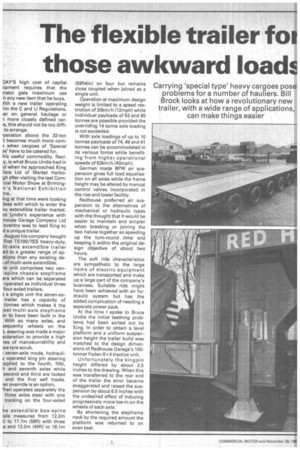The flexible trailer fo those awkward load
Page 26

If you've noticed an error in this article please click here to report it so we can fix it.
Carrying 'special type' heavy cargoes pose: problems for a number of hauliers. Bill Brock looks at how a revolutionary new trailer, with a wide range of applications, can make things easier
DAY'S high cost of capital lipment requires that the arator gets maximum use n any new item that he buys. iith a new trailer operating lin the C and U Regulations, ler on general haulage or -a more closely defined cars, this should not be too diffito arrange.
iperation above the 32-ton t becomes much more corn( when cargoes of 'Special 3s' have to be catered for.
his useful commodity, flexiy, is what Bruce Undie had in ,d when he approached King lers Ltd of Market Harbogh after visiting the last Corncial Motor Show at Birmingn's National Exhibition tre.
ing at that time were looking leas with which to enter the vy extendible trailer market. ce Undie's experience with house Garage Company Ltd :oventry was to lead King to d a unique trailer.
August his company bought first TS100/7ES heavy-duty, lti-axle extendible trailer ad to a greater range of ap3tions than any existing deiof multi-axle extendible.
le unit comprises two cen-spine chassis stepframe ers which can be separated operated as individual three four-axled trailers.
3 a single unit the seven-axtrailer has a capacity of tonnes which makes it the lest multi-axle stepframe er to have been built in the With so many axles, and ;equently wheels on the steering was made a major sideration to provide a high ree of manoeuvrability and ace tyre scrub.
seven-axle mode, hydrauliyt operated king pin steering applied to the fourth, fifth, h and seventh axles while second and third are locked and the first self tracks. ter override is an option.
'hen operated separately the three axles steer with one tracking on the four-axled
he extendible box-spine 3SiS measures from 12.2m t) to 17.7m (58ft) with three ,s and 12.2m (40ft} to 18.1m
(59ft4in) on four but remains close coupled when joined as a single unit.
Operation at maximum design weight is limited to a speed restriction of 20km/h (12mph) while individual payloads of 53 and 65 tonnes are possible provided the overriding 14 tonne axle loading is not exceeded.
With axle loadings of up to 10 tonnes payloads of 74,49 and 41 tonnes can be accommodated in its various forms while benefiting from higher operational speeds of 62km/h (40mph).
German made BPW air suspension gives full load equalisation on all axles while the frame height may be altered by manual control valves incorporated in the rise and lower facility.
Redhouse preferred air suspension to the alternatives of mechanical or hydraulic types with the thought that it would be easier to maintain and simpler when breaking or joining the two halves together so speeding up the turn-round time and keeping it within the original design objective of about two hours.
The soft ride characteristics are sympathetic to the large items of electric equipment which are transported and make up a large part of the company's business. Suitable ride might have been achieved with an hydraulic system but has the added complication of needing a separate power pack.
At the time I spoke to Bruce Undie the initial teething problems had been sorted out by King. In order to obtain a level platform and a uniform suspension height the trailer build was matched to the design dimensions of Redhouse Garage's 100tonner Foden 6x4 tractive unit.
Unfortunately the kingpin height differed by about 2.5 inches to the drawing. When this was transferred to the rear end of the trailer the error became exaggerated and raised the suspension by about 6.5 inches with the undesired effect of inducing progressively more toe-in on the wheels of each axle.
By shortening the stepframe neck by the required amount the platform was returned to an even keel.








































